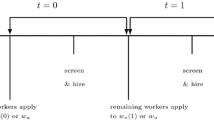Abstract
This paper analyses a simple search-and-matching model with heterogeneous jobs. First, I derive an explicit formula that ensures the social efficiency of the equilibrium outcome. This formula generalises the well-known Hosios condition and clarifies the role of externalities across labour markets for different types of jobs. Second, business cycle fluctuations with heterogeneous jobs are analysed. Heterogeneity in productivity and job stability plays an important role in generating strong labour-market responses to productivity shocks.
Similar content being viewed by others
References
Acemoglu, D. (2001) “Good Jobs Versus Bad Jobs”, Journal of Labor Economics, Vol. 19, No. 1, pp. 1–21.
Bertola, G. and R. J. Caballero (1994) “Cross-Sectional Efficiency and Labour Hoarding in a Matching Model of Unemployment”, Review of Economic Studies, Vol. 61, No. 3, pp. 435–456.
Bils, M., Y. Chang and S-B. Kim (2012) “Comparative Advantage and Unemployment”, Journal of Monetary Economics, Vol. 59, No. 2, pp. 150–165.
Davis, S. J. (2001) “The Quality Distribution of Jobs and the Structure of Wages in Search Equilibrium”, National Bureau of Economic Research Working Paper No. 8434, Cambridge, MA.
Elsby, M. W. L. and R. Michaels (2013) “Marginal Jobs, Heterogeneous Firms, and Unemployment Flows”, American Economic Journal: Macroeconomics, Vol. 5, No. 1, pp. 1–48.
Hagedorn, M. and I. Manovskii (2008) “The Cyclical Behavior of Equilibrium Unemployment and Vacancies Revisited”, American Economic Review, Vol. 98, No. 4, pp. 1692–1706.
Hall, R. E. (2017) “High Discounts and High Unemployment”, American Economic Review, Vol. 107, No. 2, pp. 305–330.
—— and P. R. Milgrom (2008) “The Limited Influence of Unemployment on the Wage Bargain”, American Economic Review, Vol. 98, No. 4, pp. 1653–1674.
Hosios, A. J. (1990) “On the Efficiency of Matching and Related Models of Search and Unemployment”, Review of Economic Studies, Vol. 57, No. 2, pp. 279–298.
Kaas, L. and P. Kircher (2015) “Efficient Firm Dynamics in a Frictional Labor Market”, American Economic Review, Vol. 105, No. 10, pp. 3030–3060.
Krusell, P., T. Mukoyama and A. Şahin (2010) “Labour-Market Matching with Precautionary Savings and Aggregate Fluctuations”, Review of Economic Studies, Vol. 77, No. 4, pp. 1477–1507.
——, ——, —— and A. A. Smith Jr (2009) “Revisiting the Welfare Effects of Eliminating the Business Cycles”, Review of Economic Dynamics, Vol. 12, No. 3, pp. 393–404.
Lee, Y. and T. Mukoyama (2015) “Entry and Exit of Manufacturing Plants over the Business Cycle”, European Economic Review, Vol. 77, pp. 20–27.
Lise, J. and J.-M. Robin (2017) “The Macrodynamics of Sorting Between Workers and Firms”, American Economic Review, Vol. 107, No. 4, pp. 1104–1135.
Ljungqvist, L. and T. J. Sargent (2012) Recursive Macroeconomic Theory, 3rd edn, Cambridge: MIT Press.
Lucas, R. E. Jr (1987) Models of Business Cycles, New York: Basil Blackwell.
Mortensen, D. T. and É. Nagypál (2007) “More on Unemployment and Vacancy Fluctuations”, Review of Economic Dynamics, Vol. 10, No. 3, pp. 327–347.
Mueller, A. I. (2017) “Separations, Sorting, and Cyclical Unemployment”, American Economic Review, Vol. 107, No. 7, pp. 2081–2107.
Mukoyama, T. (2009) “A Note on Cyclical Discount Factors and Labor Market Volatility”, mimeo., University of Virginia.
——, C. Patterson and A. Şahin (2018) “Job Search Behavior over the Business Cycle”, American Economic Journal: Macroeconomics, Vol. 10, No. 1, pp. 190–215.
—— and A. Şahin (2006) “Costs of Business Cycles for Unskilled Workers”, Journal of Monetary Economics, Vol. 53, No. 8, pp. 2179–2193.
Petrosky-Nadeau, N. and E. Wasmer (2017) Labor, Credit, and Goods Markets: The Macroeconomics of Search and Unemployment, Cambridge: MIT Press.
——and L. Zhang (2017) “Solving the Diamond-Mortensen-Pissarides Model Accurately”, Quantitative Economics, Vol. 8, No. 2, pp. 611–650.
Pissarides, C. A. (1985) “Short-run Equilibrium Dynamics of Unemployment Vacancies, and Real Wages”, American Economic Review, Vol. 75, No. 4, pp. 676–690.
——(2000) Equilibrium Unemployment Theory, 2nd edn, Cambridge: MIT Press.
—— (2009) “The Unemployment Volatility Puzzle: Is Wage Stickiness the Answer?” Econometrica, Vol. 77, No. 5, pp. 1339–1369.
Shimer, R. (2005) “The Cyclical Behavior of Equilibrium Unemployment and Vacancies”, American Economic Review, Vol. 95, No. 1, pp. 25–49.




